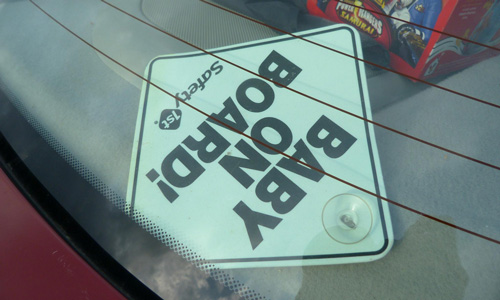Today in Tedium: It was the cup that comical YouTube unboxing videos were made for. Last year, the Mighty Mug, a drink receptacle that’s designed to not fall down under normal circumstances, gained a lot of attention from video makers the world over because of its one weird trick. Unboxer extraordinaire Lamarr Wilson, for example, was so freaked out by this cup that he took a baseball bat to it. (That did the trick, by the way.) Of course, the secret to this cup is that it’s really two cups—there’s a suction cup at the bottom that holds it up. The hours I spent watching Mighty Mug unboxing videos got me thinking about suction cups, so here I am, writing about them for today’s Tedium. — Ernie @ Tedium
“The suction cup holds it fast to anything the cup is stuck to, whether it be the wash basin, the shaving mirror or the side wall of the bathroom. The sanitary side of the device of the device is stressed, it preventing the brush from being tipped over, knocked to the floor or otherwise dirtied.”
— The first reference to suction cups in the New York Times, circa October 1925, in a small brief discussing a shaving brush holder that relied on a suction cup. The article suggested that the device would “take a good deal of the trouble out of shaving, especially on Pullman cars.” See, people talked all amazed about suction cups way back in the 1920s the way that YouTubers talk about the Mighty Mug!

Bill Nye explains suction cups. (YouTube screenshot)
The science that makes suction cups possible
Last summer, Michael Phelps decided to take to the pool in Rio with some noticeable marks all over his body. It turned out that the individual with the most Olympic medals of all time had been introduced to the Chinese art of cupping, a style of therapy involving heated glass cups that create a suction effect, and had been using it as part of his training process.
“I’ve done cupping for a while before meets,” Phelps explained, according to Time. “But I haven’t had a bruise like this for a while. I asked for a little help yesterday because I was a little sore and I was training hard.”
Whatever the case, it was good advertising for the technique, which is said to increase circulation.
“I’ve already gotten emails from a bunch of people saying, oh I need to make an appointment, I saw cupping last night,” Erika Weber, a licensed cupuncturist, told Fortune.
One thing it did not actively promote was the plastic suction cup you probably have hanging in your car to hold up your phone. But the approach is sort of like a prototype for modern-day suction cups. The devices each work by forcing out or limiting air, it creates a vacuum effect, leading to a whole lot of atmospheric pressure outside the cup that effectively holds it in place.
You know, basic science that you should have learned in the fourth grade but are helpfully being reminded of now by a newsletter. But in case you need a visual aid, this clip from Bill Nye the Science Guy explains it pretty effectively. In it, Nye describes this state of affairs using a suction cup arrow, then a vacuum-powered handle held up by a tube.
The smaller version is just more useful, of course, thanks to its flexibility. (Oh, and the fact that it doesn’t need a giant vacuum.)
“The weirdest part of the whole thing was just the pressure I felt from them putting the suction cup around my cornea. It doesn't hurt, but I could feel pressure, and the blinking light that I was looking at blurred like a kaleidoscope and then everything went black—which totally would have made me lose my shit had it not been for the Valium and their reassurances.”
— Kristina Johnston, a writer for XOVain, describing the process of going through LASIK surgery, which has become a common medical process over the years. It’s one that also relies on the use of suction. As the American Academy of Ophthalmology explains, a suction ring is used to stabilize the eye in place and flatten the cornea, allowing for a small tear in the corneal tissue so that laser can correct the lens in a person’s eye. (Johnston’s description of the procedure here is perfectly normal, by the way.)

A Baby on Board sign. (Rusty Clark/Flickr)
Five interesting facts about suction cups, in whatever form they come in
- The invention of the plunger (for toilets or otherwise) is a difficult one to nail down, but the earliest patent for a such a device came about in 1875, thanks to the handiwork of a man named John S. Hawley. “My invention has for its object to furnish a simple, convenient, and inexpensive device for clearing the vents or discharge-pipes of wash bowls, stationary wash-tubs, &c., should they become accidentally stopped,” Hawley wrote in his patent filing. As the Early Sports and Pop Culture History Blog notes, Hawley’s most notable claim to fame came in the candy industry.
- One of the most famous uses of the suction cup came about after a Boston man was tasked with driving home his 18-month-old nephew. Unfortunately, he took a busy expressway, which wracked his nerves because of his important cargo. Soon after the incident, Michael Lerner, the founder of a firm called Safety 1st, acquired the rights to the Baby on Board sign, a suctioned safety tool that became a pop-culture phenomenon in the late ‘80s.
- The common repair and upgrade process for the iMac involves suction cups, due to the massive pane of glass in front of the display, which is held on by magnets. “Stick them both on one side of the glass plate and pull up slowly,” explains one guide, by techie Marc Vos. “Not too strong, the magnetism will give way suddenly and you must have control over your muscles so the lifting of the glass remains a steady movement. When you have one side up, you can lift the whole plate off and put it aside.“
- There are, of course, different grades of suction cups, some of which are powerful enough to let you walk on walls. Last year for example, a 20-year-old kid named Stephen Rogata climbed up Trump Tower using these suction cups, which are powerful, but not designed for this purpose. A set of suction cups that are designed for this purpose were made in Germany, for a project called Gekkomat.
- And science could eventually help us find an even better suction cup. Researchers at the University of Alaska Anchorage are currently working on prototype suction cups designed to work on rough or wet surfaces, with its approach inspired by the clingfish, an animal that’s naturally accustomed to such suctioning.

The company that built its name on suction cups
As you might imagine, Bill Adams didn’t decide one day to start manufacturing suction cups. He really was focused on a different idea entirely—but it turned out he needed to simplify.
In the late 1970s, Adams attempted to build a business for himself with the help of a device called the “window blanket,” essentially a piece of bubble wrap that homeowners would attach to attic windows using suction cups. Window blankets were a thing at the time, but Adams’ solution didn’t make headway in the market, leaving him stuck with a whole lot of bubble wrap and even more suction cups.
Fortunately, he saw an opportunity in the various stores he traveled around, many of which were putting up their signage inefficiently.
“I got the idea for suction cups when I saw that many businesses had signs in their window held by duct tape,” Adams told the Ellwood City Ledger last year. “I would stop and show them how the suction cups and tacks could hold their signs, look good and leave no mess when they were removed.”
So he ended up focusing on suction cups instead. Soon, his company was selling the tiny little vacuums at retail, with things picking up after he started selling to a buyer for True Value Hardware. Good start, but there were problems with the original design. A Mercedes owner pointed out that his company’s suction cup damaged his vehicle because they unwittingly worked like magnifying glasses.
“It was then that he realized that not only must suction cups be perfectly made in order to work, but they also should be re-engineered to do no harm,” the company states on its website. “He redesigned the suction cups to disperse, rather than focus, light.”
So they kept at it, and by 1992, Adams Manufacturing had become the largest manufacturer of suction cups in the country, selling 50 million of them a year, according to an Associated Press article from that year. Adams noted at the time that he would get fan mail from people who used the suction cups in unusual ways—including one guy who used it to put down his toilet seat, for the sake of his frustrated wife.
"He rigged up a contraption that would drop the toilet seat after a minute and a half," Adams told the wire service. "It may not have commercial possibilities, but it was a good idea."
The firm remains active to this day, with the U.S.-based company competing against Chinese manufacturers by creating the best damn suction cups around, emphasizing its decades of research and development work. “We hold a PhD in Suction Cup-Ology,” the company claims on its website.
And these days, Adams isn’t just known for suction cups—the firm, expanding its reach over the years, is also the largest U.S.-based manufacturer of outdoor resin furniture. When reflecting on how his firm stuck around, Adams admits he got lucky.
“I was blessed,” he told the Elmwood City Ledger. “In the beginning, we were very underfunded. It was touch and go.”
Odds are, you’ve gotten all the way down here and wondered to yourself: Well, what about licking suction cups?
Well, maybe not licking, specifically—admit it, you’ve probably done it—but is wetting a suction cup a good idea, usually?
To put it simply, wetting isn’t a bad idea, because it helps to make up for the limitations in the material. Essentially, adding molecules of liquid crowds out the air, making the vacuum seal even tighter.
For its part, Adams Manufacturing recommends “a tiny dab of Vaseline or cooking oil” to improve the seal, but that it’s important to rely on a clean surface when you do suction it up. (The liquid is not always necessary, though; in a 1999 Pittsburgh Post-Gazette article, Bill Adams noted that the company’s mold for building suction cups is “smoother than your eyeball.”)
Whether or not you wet your suction cups with your tongue or not? We’ll leave that up to you.




